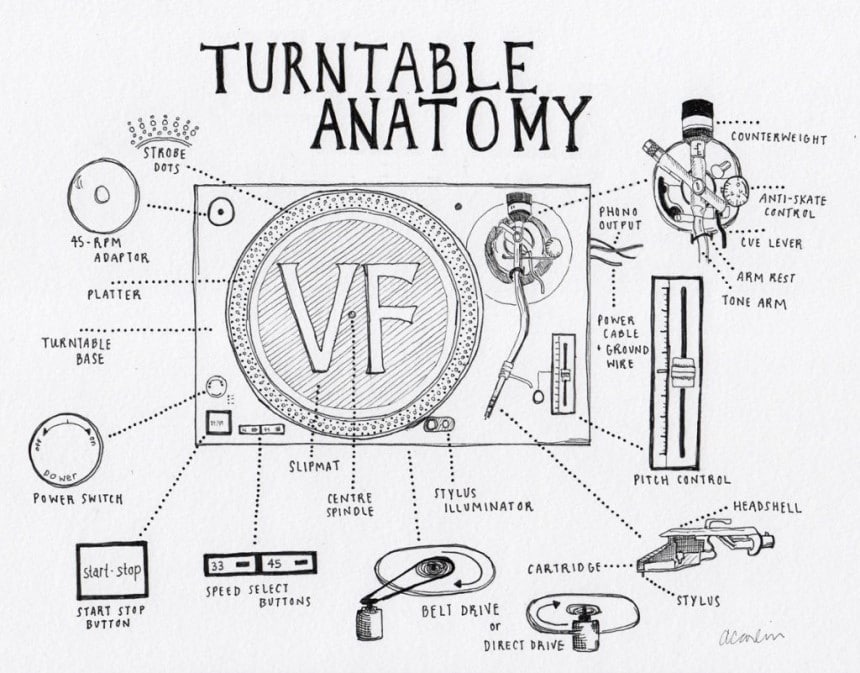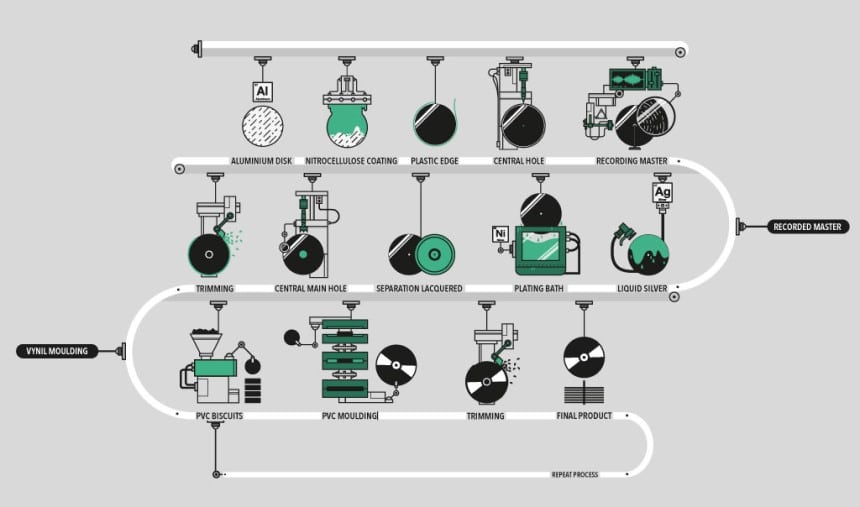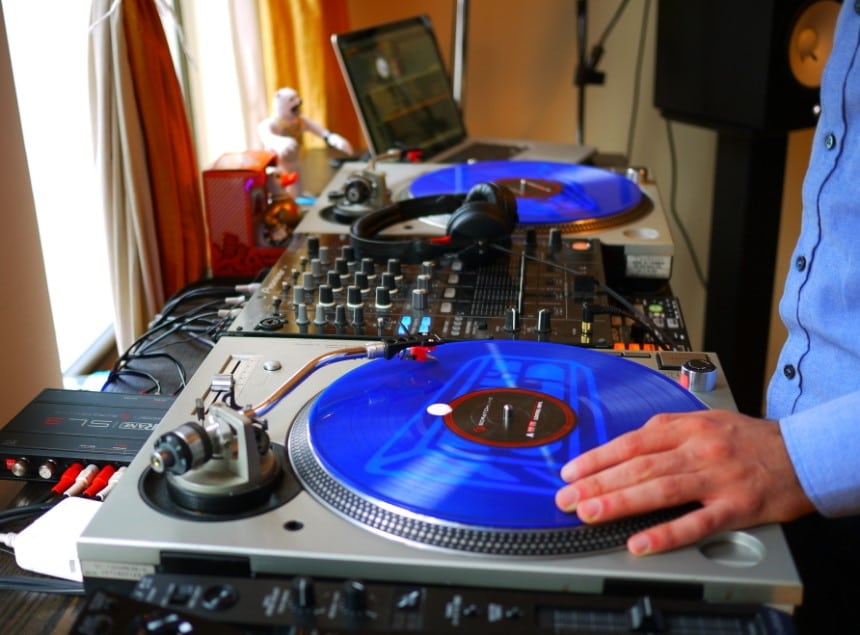We live in a digital age where almost everything is digitalized Trusted Source Audio file format - Wikipedia An audio file format is a file format for storing digital audio data on a computer system. The bit layout of the audio data (excluding metadata) is called the audio coding format and can be uncompressed, or compressed to reduce the file size, often using lossy compression. en.wikipedia.org . Therefore, you might not be familiar with a record player. Or perhaps you are. You might be part of a growing number of people that are interested in record players, buying as many records as you can just to listen to how music sounded in the past. Or you might even be an aficionado, with vinyl records lining every inch of your shelf. Whichever way you are, you might not completely understand how a record player works.
It can be mysterious how this equipment manages to make music. Is it sound waves, or is the sound etched into the record and then replayed? It might be confusing. However, do not fret. We are here to help you. To that end, we have created this article. Here we will discuss how the record player works. We will see why vinyl record players are so awesome, how to maintain it, and so much more. So read on to find out all these and more.
In the simplest of terms, the vinyl record player works by spinning the vinyl record on the platter while a stylus moves through the grooves of the record. The stylus, which we will discuss in more detail later, is usually made of high-grade, durable material and is attached to the tonearm of the record player. This tip, or stylus, interprets the grooves on the vinyl record by creating an electrical signal and transmitting that signal from the equipment’s cartridge to the amplifier. This is where the sound is then produced. Regardless of what the cartridge uses to work, whether electricity or magnetism, it will provide the signal to the amplifier.
Since there are MP3 players, smartphones, and other ways of listening to music, you might wonder why anyone would be interested in listening to songs of a record player. Why go through the stress of setting up the player if you could play music with just the touch of a button?
Well, we will cover some of the best things about playing vinyl record players.
Vinyl is the only music format that comes as completely analog and lossless. What does this mean? It implies that with the right model of turntable and speed, you will get the best listening experience. It offers a genuine listening experience and will give the listener a full-fidelity experience.
As it is an analog format, musicians can transport their songs right to you without the complexities of digitizing their music. You will get the sounds that the musician intended for listeners. The Victrola Navigator record player is a vintage turntable option that comes with some of the newest technology like USB connectivity.
Another benefit of listening to vinyl records is that it gives you a feeling of nostalgia and warmth that you simply cannot get from listening via a digital device. The warmth of the sound is akin to listening to live music. This is better than what you find in digital options.
Vinyl records will never sound as loud as digital records. But that is not a good thing, right? Wrong. In truth, it is a benefit. How? Well, digital producers often go over the top and make their songs as loud as possible. The trade-off is that the songs produced don’t have the dynamics and textures that make recordings so pleasant to hear.
You don’t have that problem with vinyl records. They give you the dynamics and the textures that will make songs sound alive.
Unlike the digital forms of music, vinyl records are physical and dust particles might get stuck in the grooves. Therefore, no matter how well you clean, you will hear crackles. Some might not like that, but many vinyl aficionados believe that this is one of the things that gives vinyl records their appeal. This surface noise is recognizable wherever you hear them and will invoke a feeling of nostalgia in most listeners.
You simply have to take time to listen to vinyl records. In this fast-paced world, sometimes it is good to just take a break from it all.
Listening to records is an elaborate process, which takes time and puts you in a mood. Good music requires your attention, and vinyl records ensure that you pay attention.
While this isn’t related to the sound, it is part of the entire experience. Original vinyl records come in sleeves that are designed by the artist, and this cover art will be something that enhances the overall experience. You will therefore have the whole music the way the artist desired.

To understand how the record player works, you must know the different parts that make up a typical record player. While there are several models on the market, all of them possess these basic components.
These are the:
This section aims to carefully consider what these parts are, and see how they work in a record player. When you know what each part does, you will have better information or an idea of how the record player works.
This is arguably the most important part of the record player. When you hear the word ‘turntable’ chances are pretty decent that you assume that it describes the entire equipment. However, that is not right. The turntable, or the platter, is simply one of the different parts that make up the record player. It is certainly not the same as the record player.
So, what is the difference between the two? Well, the turntable is the part of the equipment where you place the record. The record player is the term for the entire machine.
There are different materials used to create the turntable, however, the most common materials are aluminum and steel. Steel is great, however, it has low inertia which can affect the quality of the sound. Aluminum turntables are better but more expensive. They are better in terms of offering more stability and are heavy enough to reduce vibration while boosting balance.
The belt drive option is cool as it gives you great sound since it will absorb most of the interference including vibration.
The direct drive is also good, albeit inferior to the belt drive in terms of the quality of the sound produced. It is the drive used by DJs.
The stylus or needle is the part of the turntable that runs in the grooves of the vinyl record. It moves quickly, which causes wear. That is why it is usually made of diamond or some other hard material.
The stylus is available in an elliptical or a spherical shape. Elliptical shapes are good since the grooves touch the stylus more, thus improving the quality of playback. The spherical shape is also nice because of the increased sensitivity. However, the sound is not as good.
The tonearm is either straight or curved, although that doesn’t affect the sound quality. The tonearm houses the stylus and is connected to the cartridge.
The cartridge is where the signals from the stylus go and it is what transfers the signals to the preamp or amplifier.
The sounds are then sent to speakers to give the sound.
These are the components that will create audible music. They transmit sound signals from the record player to the speakers.
The traditional record players are in truth electromagnetic equipment that converts sound vibrations into electric signals and back into sound. As the record or vinyl spins on the turntable, unique vibrations are created, and these vibrations are picked up by the stylus. The stylus then feeds the signals through the tonearm up to the cartridge. The cartridge passes the signal to a preamp or an amp, depending on the setup, which then passes to speakers to give the rich sound from the turntable.
In one of the sections above, we considered the different components that combine to make up the record player. Well, the needle, which some also refer to as the stylus, is an essential part of the equipment. It combines with other parts of the machine, like the tonearm and the cartridge to be a transducer. And what is the function of a transducer? Well, the transducer is an equipment that works by changing mechanical energy into electrical energy and vice-versa. The complete system that makes up the transducer, in terms of the record table, is the stylus, magnets, cantilever, and the body inside a cartridge. As we said earlier, the energy from the sound waves produced on the turntable is changed into electrical signals that pass to the amp and then to the speakers.
The vinyl player plays records because of the way a vinyl record is made.
 In creating the record, a needle is used to make grooves in the vinyl. This is, in its purest form, information. It is writing the music in the grooves of the vinyl. So, when the vinyl is played on a record player, the stylus of the player reads the information in the grooves and plays it back so you can hear the created music. The typical groove of any record has a left and right side. Both sides serve as information channels that combine to create stereo sound.
In creating the record, a needle is used to make grooves in the vinyl. This is, in its purest form, information. It is writing the music in the grooves of the vinyl. So, when the vinyl is played on a record player, the stylus of the player reads the information in the grooves and plays it back so you can hear the created music. The typical groove of any record has a left and right side. Both sides serve as information channels that combine to create stereo sound.
Records have master copies. This copy is created by using a needle to create grooves in a round disk. Then it is packed to be created into the master copy of the record. There are certain differences between the master copy and the usual copies of a record. For one, instead of grooves, the master copy has ridges.
In other words, the master copy is the ‘Underworld’ imprint of the record. This master copy is then pressed into soft vinyl with the aid of a hydraulic press to imprint the song. After the ridges have been pressed into the soft vinyl disc, the disc is then hardened by placing it in cool water.
The final result is the vinyl that we can see and listen to today.
After the creation of the record, it can then be played on a record player. Many people assume that the turntable and the record player are the same, but as we have seen from the Components section that is not true. The turntable spins the wheels or record placed on it with an electric motor.
The DJ turntable is the focus of this section. This turntable is the midpoint of any DJ’s art. Outsiders consider it to be a different aspect of sound engineering, with some going as far to label it as being rebellious. It has such a reputation because of the carefree and wild nature. In simple terms, the DJ turntable is a digitized record player. Instead of all the parts that make up the regular turntable, this is a CD player that features a slip pad disc to form the platter as can be found on the regular record player.
With this type of record player, the DJ can play different sounds. It allows him to electrically create scratchy sounds and effects. This is achieved in different ways, but mainly by reversing the slip pads. With this device, sounds can be mixed to make new songs for parties and raves. These are the main tool of any DJ and is what they use to create soundtracks. Since the evolution of the DJ turntable, it has further expanded into different devices, ranging from models that can play vinyl records to those that focus on CDJ decking.
Considering the advancements, you might be surprised to discover that many DJs today still have analog and digital turntables as part of what they use for their gigs and in creating music. However, these come with more modifications than ever before, which has made them different from the typical turntable or record player. Today, DJs have tracks that they have made before the gig, and they mix this with other tracks to create something new.
The digital turntables can manipulate the tempo and the beat of the music. So, it is easier for DJs to use them since all that is required is to record the sound and make it into a new track.
 To know how the DJ turntable works, you have to know the parts that make up the DJ turntable. In an earlier section, we have considered the components of a regular record player. However, the DJ turntable comes with certain differences. In this section, we will consider the parts that make up this equipment.
To know how the DJ turntable works, you have to know the parts that make up the DJ turntable. In an earlier section, we have considered the components of a regular record player. However, the DJ turntable comes with certain differences. In this section, we will consider the parts that make up this equipment.
First, the turntable has a base. The base, as implied by the name, describes the foundation of the equipment. Without the base, you cannot have the equipment because this is where the motor that moves the entire equipment lies.
After the base, you have the platter or the turntable. The platter is an essential component too because it will, almost more than any other part, affect the quality of your music the most. It is the platter that gives the track played consistency. For DJs, a heavy platter is a requirement because that is what will make the sound steady.
The platter, like that of a regular record player, is where the vinyl is set. For DJs, it is where the record or vinyl is placed and the DJs scratch and mix to create their unique sound. Without the platter, they cannot display their skills.
The next and the last part is the arm. The arm is also vital because it houses other important components. It is the most complex part of the equipment. The arm extends from the base and is set at a distance from the platter to reduce the shaking and vibrations that might occur while playing a record. The tip of the arm has the cartridge. The cartridge touches the playing record or disc. When it touches the platter, it transmits the signals from the groove into sound waves and then sends that to an amp0lifier. The cartridge works using either magnetism or a moving coil.
It is the movement of the rotating platter with the record on it and the cartridge lining the vinyl that creates small variations in the field, which then transmits to the arm and gives the sound.
Now, the DJ turntable comes with certain differences. It comes with a button or knob that allows the DJs to scratch the songs without a drop in the quality of the music. If you are an aspiring DJ, you will likely love the Pioneer DJ turntable. It is a value buy that comes with all the functions that you’ll ever need.
So there you have it – how a record player works. Join the growing throng of people who are interested in owning these beautiful, classy, and elegant music players. Know that you know how they work, why don’t you order one and enjoy a wonderful listening experience!